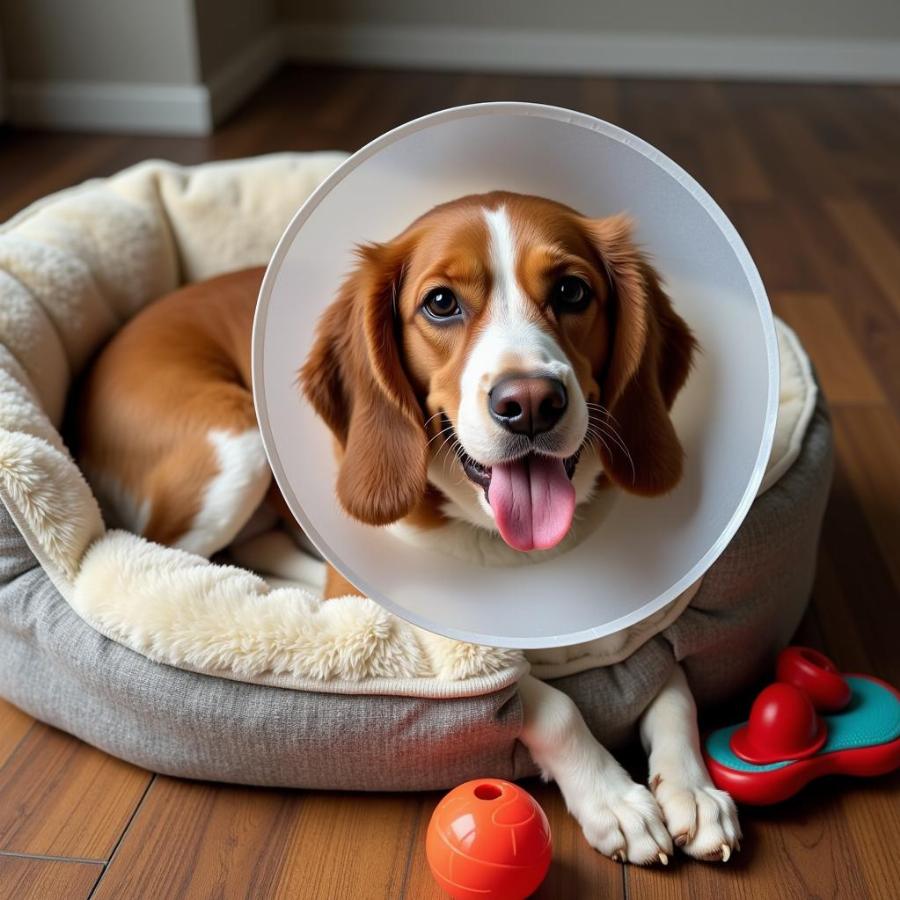Deciding whether or not to have hip dysplasia surgery for your beloved canine companion is a big decision. This comprehensive guide explores everything you need to know about hip dysplasia surgery dog, from understanding the procedure itself to navigating the recovery process. We aim to provide you with the information you need to make the best choice for your furry friend.
What is Hip Dysplasia in Dogs?
Hip dysplasia is a common skeletal condition that affects dogs, particularly larger breeds. It occurs when the hip joint doesn’t develop properly, leading to a loose and unstable joint. This can cause pain, lameness, and eventually, arthritis.
Signs and Symptoms of Hip Dysplasia
Recognizing the signs of hip dysplasia early on is crucial. Some common indicators include:
- Difficulty rising, jumping, or climbing stairs
- Limping or a “bunny hopping” gait
- Stiffness, especially after rest
- Decreased activity level
- Grating or clicking sound in the hip joint
- Pain when the hip area is touched
If you notice any of these signs in your dog, consult with your veterinarian for a proper diagnosis.
Diagnosing Hip Dysplasia: What to Expect
Your veterinarian will conduct a physical examination and may recommend imaging tests such as X-rays to confirm the diagnosis and assess the severity of the condition.
When is Hip Dysplasia Surgery Recommended?
The decision for surgery depends on several factors, including:
- Severity of the dysplasia
- Your dog’s age and overall health
- Lifestyle and activity level
- Your veterinarian’s recommendation
Types of Hip Dysplasia Surgery for Dogs
There are several surgical options available for treating hip dysplasia in dogs:
1. Femoral Head Ostectomy (FHO)
This procedure involves removing the head and neck of the femur (thigh bone), allowing the surrounding muscles to form a “false joint.” FHO is often recommended for smaller dogs or those with severe arthritis.
2. Total Hip Replacement (THR)
THR involves replacing the damaged hip joint with an artificial implant. This is a more complex surgery but offers excellent long-term outcomes, particularly for active dogs.
3. Triple Pelvic Osteotomy (TPO)
TPO is typically performed on younger dogs where the hip socket hasn’t fully developed. The procedure involves cutting and rotating the pelvis to improve the coverage of the femoral head.
What to Expect After Hip Dysplasia Surgery
After surgery, your dog will need:
- Pain management: Your veterinarian will prescribe pain medication to keep your dog comfortable.
- Restricted activity: Strict rest is crucial during the initial recovery period to allow the surgical site to heal properly.
- Physical therapy: Exercises and rehabilitation therapies can help improve range of motion, muscle strength, and overall recovery.
Long-term Care After Surgery
 Dog Recovering After Hip Surgery
Dog Recovering After Hip Surgery
Even after surgery, your dog will need ongoing care to manage their condition:
- Weight management: Maintaining a healthy weight is crucial to minimize stress on the hips.
- Joint supplements: Supplements like glucosamine and chondroitin can help support joint health and slow down the progression of arthritis.
- Regular veterinary check-ups: Regular monitoring by your veterinarian is essential to track your dog’s progress and address any potential issues.
Cost of Hip Dysplasia Surgery in Dogs
The cost of hip dysplasia surgery can vary depending on several factors, such as the type of surgery, geographic location, and veterinarian’s fees.
Alternatives to Surgery
In some cases, non-surgical management may be an option for dogs with hip dysplasia:
- Weight management
- Exercise modification
- Physical therapy
- Medications (pain relievers, anti-inflammatories, joint supplements)
Choosing the Right Treatment Option for Your Dog
“Every dog is different, and the best treatment plan for hip dysplasia is tailored to the individual patient. Factors such as age, breed, lifestyle, and overall health all play a role in determining the most suitable course of action.” – Dr. Emily Carter, Veterinary Surgeon.
Navigating hip dysplasia in dogs can feel overwhelming, but with the right information and support, you can make the best choices for your furry friend’s health and well-being.
Frequently Asked Questions
Q: Can hip dysplasia in dogs be cured?
A: While there is no cure for hip dysplasia, surgery and non-surgical management options can significantly improve your dog’s quality of life.
Q: What is the success rate of hip dysplasia surgery in dogs?
A: The success rate varies depending on the type of surgery performed and the individual dog. Generally, hip dysplasia surgery has a high success rate in improving mobility and reducing pain.
Q: How long is the recovery time after hip dysplasia surgery?
A: Recovery time can range from several weeks to a few months, depending on the type of surgery and your dog’s individual healing process.
Looking for More Information?
Check out these helpful resources:
- Dog stairs steps: Provide your dog with easy access to furniture and cars with supportive dog stairs.
- Chewy orthopedic dog bed: Offer your dog a comfortable and supportive sleeping surface with an orthopedic dog bed.
Need help choosing the right hip dysplasia treatment for your dog? Contact Beaut Dogs at [email protected] for personalized advice and support.
Beaut Dogs is your trusted source for all things dog-related. We provide expert advice, tips, and resources to help you give your canine companion the best possible care.